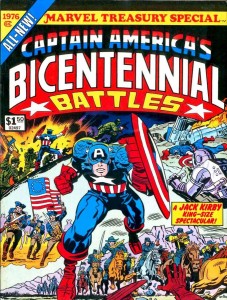
In 1940, comic book artist Joe Simon was doodling ideas onto a piece of paper trying to come up with the next big superhero. Ever since Superman hit in 1938, comics had been big business, and with a world war looming, patriotic heroes such as The Shield were selling lots of comic books. So Simon sketched out a very similar-looking guy wearing a very similar-looking flag costume — and gave him a shield, too. Simon first called him “Super American.” He wisely changed it. Simon handed it over to artist Jack Kirby and Captain American Comics #1 came out in 1941, featuring the newly-named Captain America socking Hitler right on the jaw. It sold a million copies.
But Simon had another story as to who inspired Captain America. In his autobiography Joe Simon: My Life in Comics (Titan Books, 2011), Simon recalls a childhood memory:
There were many incidents that inspired my search for the great American hero. A pivotal one occurred when I was eight or nine years old in public school in Rochester . . . This was my first contact with a living legend, a fragile little old man, obviously bewildered, dressed in a blue Civil War uniform worn thin over the years . . . Our teacher, a pretty young woman whose military knowledge was limited, just presented him as “The Soldier.” That was enough for us kids — he was The Soldier, plain and simple . . .
The little soldier stepped forward. Beginning with the student in the back left corner of the room, he extended his right hand, and shook the seated kid’s hand. As he did, he said these words: “Shake the hand that shook the hand of Abraham Lincoln!” He moved from desk to desk, shook every hand, and repeated the same message to all. Wow! Historic? More than that…it was iconic.
I would always remember the odd little fighting man as I continued my life-long quest for the great American Hero.
I never learned the man’s name.
Was there really a mysterious soldier from the past who served as the inspiration for Captain America? Or is this just another fish story told by a Golden Age comics creator to protect himself from charges of plagiarism?
“The Soldier,” the man who inspired Captain America, was real.
And I think I know his name.
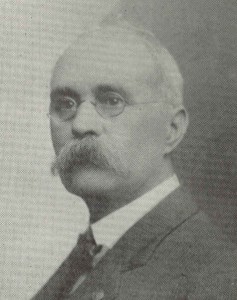
To show you how things have changed, we used to think it was a wonderful Christmas if we got a doughnut and a stick of candy and a few nuts of some kind. Our favorite holiday was the Fourth of July.
When Lincoln called for volunteers, Hard enlisted in the Union Army almost immediately (possibly lying about his age). The regiment soon found itself in Washington:
It was then that I met President Lincoln the first time. It was in May, 1861, at a reception in the Blue Room in the White House.I shook hands with Mr. and Mrs. Lincoln and little Bobby Lincoln. We hadn’t got our uniforms yet and Mr. Lincoln said, “Son, you look as if you’d make a good soldier. Why don’t you join up?”I explained to him I was in the Army, and I don’t remember what he said. But he gave me a smile I always remembered. Whenever he spoke to anyone he had a wonderful smile. And he gave a handshake with a grip that nearly crushed my hand. I thought his hand was as big as a ham, it took mine right out of sight.
During the Civil War, Hard served in the 32nd New York Infantry and fought at Bull Run, Antietam, Fredericksburg, and West Point, among other places. Their regiment lost 99 men to disease and battle.
James A. Hard survived the War, leaving it with the same rank he entered it with: Private. He eventually settled in Rochester, New York where he studied law and opened a pension office, often helping veterans like himself.
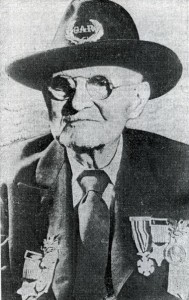
He would live another thirty-one years. As he became one of the last living veterans of the Civil War, newspapers would start to talk to him about elections and other national events. Hard was especially proud of having voted for a straight Republican ticket in every election since Lincoln. When Hard died in 1953, he had survived two wives, a daughter, and was the second-longest living American veteran of the Civil War. He was 111 and smoked a cigar every day.
When Captain America debuted, the publishers of The Shield weren’t too happy, especially with Cap’s triangular shield, which looked a lot like their character’s costume. So in issue #2, Captain America’s shield became the round disc we are familiar with today. Joe Simon, who died in 2011, at age 98, remembered something else about his youthful encounter with James Hard:
He faced the class. Proudly he unfurled the flag — to the cheers of his eager young audience. This was a banner I had never seen before. It had the same number of red stripes as today, four above the union, three below. However, the blue union area in the upper corner carried a single five-pointed star made up of 35 smaller stars.
America may have been conceived of as an ideal, but it is also always an experiment. In the comics and movies, Cap tests and redefines that ideal against threats from within and without. Captain America, like all superheroes, has many sources. But somewhere in that mix is a small, old soldier who didn’t win any honors or medals. Somewhere in there is an ordinary man who served and survived extraordinary times without giving any ground. Somewhere in there is a symbol. James A. Hard not only survived a war, but he inspired and helped others in a shifting, changing America for over a century. That might be the best Captain America story of all.
Brad Ricca is the author of Super Boys: The Amazing Adventures of Jerry Siegel & Joe Shuster – The Creators of Superman and American Mastodon. Visit www.super-boys.com and follow @BradJRicca.


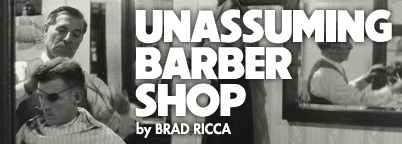
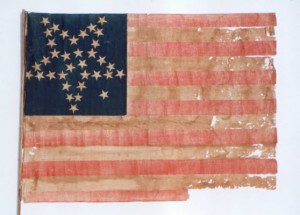
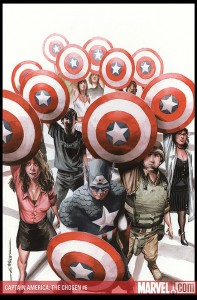


Great story!!! Brought a tear to my eye, it did, and that is NOT a joke.
Wow, man, so I’m three handshakes from Abraham Lincoln! I met Joe in the 90’s.
Very cool story.
A footnote:
The U.S. flag did not have an official star pattern until 1912.
Star arrangements were popular from 1818 (when the current “13 stripes, one star per state” law was passed) up through the Civil War, but were replaced by circles after Nevada joined the Union. Circles disappeared after 1890.
I suspect that flag manufacturers had flags in inventory with 34 stars, and added the extra star when West Virginia split from Virginia.
Kansas became the 34th state on January 29, 1861, and West Virginia seceded from Virginia and became a state on June 20, 1863. Nevada became the 36th state on October 31, 1864, so this design was not long lived.
http://www.jeffbridgman.com/inventory/index.php?id=1&page=out
great story of two exceptional americans. thanks.
This was a fascinating read. The kind of obscure & insightful article that The Beat could use more of.
Yeah, I’m with @MHF (and all the other comments) — this was a great article. Informative. Engaging. Relevant to comics. And very unique.
It’s a refreshing contrast to rumors, press releases, and tales of our dysfunctional culture and industry politics that occupy much of the comics Interweb. Thanks, Brad!
Thanks all — I really appreciate it. This story ended up on Yahoo News if you can stay awake til the end.
http://news.yahoo.com/video/brad-ricca-interview-222718156.html
Thanks for posting this, Brad! I remember reading Joe’s account of meeting The Solider who shook Lincoln’s hand and shook Joe’s hand. I have fond memories of interviewing Joe for my article on his and jack Kirby’self-publishing venture Mainline Publications from back in 1954. It ran in The jack Kirby Collector #25 special S&K issue about 14 years ago now.
I wish I knew then what I know now which would have formulated better questions at the time And thanks for all the foot note references to my work you used in Super Boys. Researching Jerry & Joe’s earliest attempts at trying to get published was a lot of fun back in the mid 90s. It was a real live mystery to unravel. You took some kernals of uncovered data and made a huge neat oak tree out of it all !!
Comments are closed.